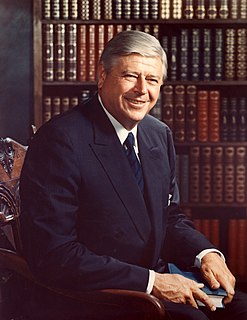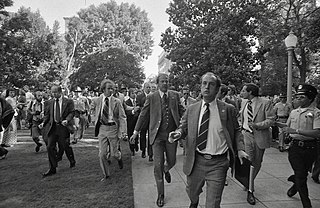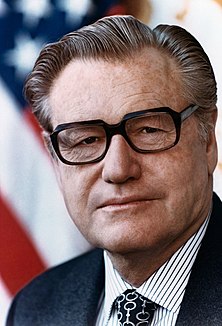
EmperorShōwa, better known in English by his personal name Hirohito (裕仁), was the 124th emperor of Japan, ruling over the Empire of Japan from 1926 until 1947, after which he was Emperor of the state of Japan until his death in 1989. He was succeeded by his fifth child and eldest son, Akihito. Hirohito and his wife, Empress Kōjun, had seven children, two sons and five daughters. By 1979, Hirohito was the only monarch in the world with the title "emperor". Hirohito was the longest-lived and longest-reigning historical Japanese emperor and one of the longest-reigning monarchs in the world.

Empress Kōjun, born Princess Nagako, was a member of the Imperial House of Japan, the wife of Emperor Shōwa (Hirohito) and the mother of Shigeko Higashikuni, Princess Sachiko Hisa-nomiya, Kazuko Takatsukasa, Atsuko Ikeda, the Emperor Emeritus Akihito, Prince Masahito Hitachi-nomiya and Takako Shimazu.

The United States Bicentennial was a series of celebrations and observances during the mid-1970s that paid tribute to historical events leading up to the creation of the United States of America as an independent republic. It was a central event in the memory of the American Revolution. The Bicentennial culminated on Sunday, July 4, 1976, with the 200th anniversary of the adoption of the Declaration of Independence.

James Rodney Schlesinger was an American economist and public servant who was best known for serving as Secretary of Defense from 1973 to 1975 under Presidents Richard Nixon and Gerald Ford. Prior to becoming Secretary of Defense, he served as Chair of the Atomic Energy Commission (AEC) from 1971 to 1973, and as CIA Director for a few months in 1973. He became America's first Secretary of Energy under Jimmy Carter in 1977, serving until 1979.

Gerald Ford's tenure as the 38th president of the United States began on August 9, 1974, upon the resignation of Richard Nixon from office, and ended on January 20, 1977, a period of 895 days. Ford, a Republican from Michigan, had served as vice president since December 6, 1973, following Spiro Agnew's resignation from that office. Ford has the distinction of being the only person to serve as president without being elected to either the presidency or the vice presidency. His presidency ended following his defeat in the 1976 presidential election by Democrat Jimmy Carter.

Leslie Cornelius Arends was a Republican politician from Illinois who served in the United States House of Representatives from 1935 until 1974.

Rogers Clark Ballard Morton was an American politician who served as the U.S. Secretary of the Interior and Secretary of Commerce during the administrations of Presidents Richard M. Nixon and Gerald R. Ford, Jr., respectively. He also served as a member of the U.S. House of Representatives from Maryland.

USS Sequoia is the former presidential yacht used during the administrations of Herbert Hoover through Jimmy Carter; setting a cost-cutting example, Carter ordered her sold in 1977.

The Watergate scandal refers to the burglary and illegal wiretapping of the headquarters of the Democratic National Committee, in the Watergate complex, by members of President Richard Nixon's re-election campaign and the subsequent cover-up of the break-in resulting in Nixon's resignation on August 9, 1974, as well as other abuses of power by the Nixon White House that were discovered during the course of the scandal.

The 1960 National Convention of the Republican Party of the United States was held in Chicago, Illinois, from July 25 to July 28, 1960, at the International Amphitheatre. It was the 14th and most recent time overall that Chicago hosted the Republican National Convention, more times than any other city.

Gerald Rudolph Ford Jr. was an American politician who served as the 38th president of the United States from 1974 to 1977. Earlier, he served as leader of the Republican Party in the House of Representatives, and then as the 40th vice president of the United States from 1973 to 1974. When President Richard Nixon resigned in 1974, Ford succeeded to the presidency, but was defeated for election to a full term in 1976.
The vice president-elect of the United States is the candidate who has won election to the office of vice president of the United States in an United States presidential election, but is awaiting inauguration to assume the office.

The desk in the Vice President's Room of the United States Capitol, colloquially known as the Wilson desk and previously called the McKinley-Barkley desk, is a large mahogany desk used by Presidents Richard Nixon and Gerald Ford in the Oval Office as their Oval Office desk. One of only six desks used by a President in the Oval Office, it was purchased in 1898 by Garret Augustus Hobart, the 24th Vice President of the United States, for the Vice President's Room in the United States Capitol.

On September 5, 1975, Lynette "Squeaky" Fromme, a member of the Manson Family cult, attempted to assassinate United States president Gerald Ford in Sacramento, California. She wanted to make a statement to people who refused to halt environmental pollution and its effects on air, trees, water, and animals (ATWA). Although Fromme stood a little more than an arm's length from Ford that Friday morning and pointed a M1911 pistol at him in the public grounds of the California State Capitol building, she had not chambered a round, the gun did not fire, and no one was injured. After the assassination attempt, Ford continued to walk to the California state house, where he met with Governor Jerry Brown. For her crime, Fromme spent 34 years in prison and was released on August 14, 2009 – two years and seven months after Ford's death. The Gerald R. Ford Presidential Museum in Grand Rapids, Michigan, later received the M1911 pistol used in the assassination attempt as a gift, and the gun was put on display.

On August 9, 1974, Republican President Richard Nixon was forced to resign amid the Watergate Scandal. Vice President Gerald Ford ascended to the presidency, leaving the office of vice president vacant. Under the terms of the 25th Amendment, a vice presidential vacancy is filled when the president nominates a candidate who is confirmed by both houses of Congress, which were controlled by the Democrats.

In 1973, Republican Vice President Spiro Agnew was forced to resign following a controversy over his personal taxes. Under the terms of the 25th Amendment, a vice presidential vacancy is filled when the president nominates a candidate who is confirmed by both houses of Congress. Republican President Richard Nixon thus had the task of selecting a vice president who could receive the majority support of both houses of Congress, which were then controlled by the Democrats.

Proclamation 4311 was a presidential proclamation issued by President of the United States Gerald Ford on September 8, 1974, granting a full and unconditional pardon to Richard Nixon, his predecessor, for any crimes that he might have committed against the United States as president. In particular, the pardon covered Nixon's actions during the Watergate scandal. In a televised broadcast to the nation, Ford, who had succeeded to the presidency upon Nixon's resignation, explained that he felt the pardon was in the best interests of the country and that the Nixon family's situation was "a tragedy in which we all have played a part. It could go on and on and on, or someone must write the end to it. I have concluded that only I can do that, and if I can, I must."

Vietnam Humanitarian Assistance and Evacuation Act of 1975 was U.S. congressional legislation proposed to designate financial resources for the evacuation and humanitarian aid of South Vietnam preceding the Fall of Saigon. The Act of Congress was to grant the 38th President of the United States a U.S. monetary fund as immediate foreign assistance for the South Indochina liberation movement during the military offensive by the People's Army of Vietnam, People's Liberation Armed Forces of South Vietnam, Viet Cong, and Viet Minh into Cochinchina.
The following is a timeline of the presidency of Gerald Ford from January 1, 1975, to December 31, 1975.
















